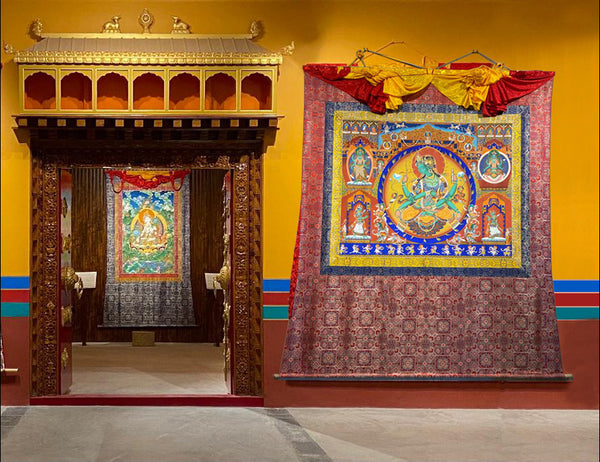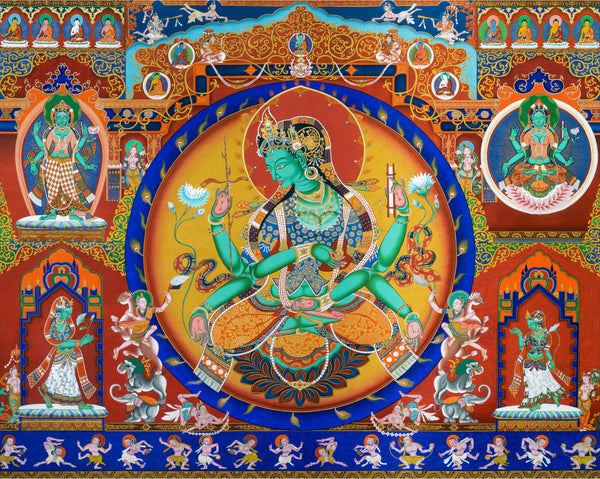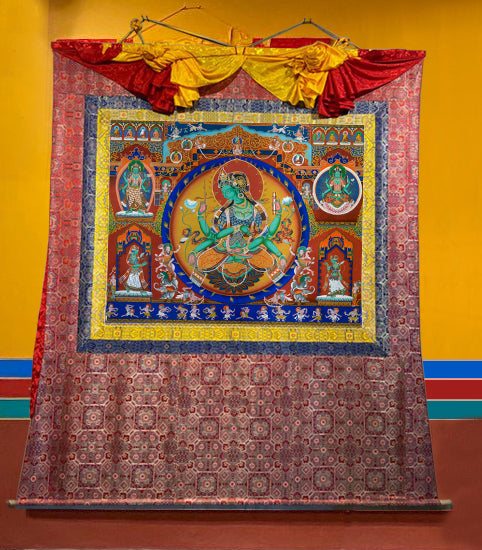4-5 Feet Alchi Tara in Celestial Abode (8-10 Feet with silk mount)
Alchi Tara in Celestial Abode
959 CE - 1350 CE
Artist: Master Locho and Sarika Singh
Five Years in Making ( 2014- 2020)
This representation of the Green Tara was created in the style of the murals adorning the walls of the Alchi monastery in the Leh district of Ladakh, which is currently a part of the larger state of Jammu and Kashmir. Buddhism was first introduced to the region in the first or second century as it spread from neighboring Kashmir. Sandwiched between Kashmir and the Western Tibetan Empire, the region was under the control of one or the other of these powers through the first millennium.
Under the rule of King Yeshe-Ö of the Guge kingdom in the southwestern Tibetan Plateau, which includesLadakh, from 959-1040 CE, there was a second diffusion of Buddhism that sought to reaffirm the religiosity of the kingdom. This monastery was built at the same time as Tabo monastery, under the leadership of Rinchen Zangpo, who translated scripts and supposedly erected over 100 monasteries.
The Alchi Monastery was one of these 100 monasteries erected under the influence of Rinchen Zangpo, however the most of monasteries in Ladakh truly flourished from the eleventh to nineteenth century when this region enjoyed the status of an independent kingdom. 70 kilometers from the city of Leh, the Alchi monastery is an unassuming building known as AlchiChos-khor, which translates to 'secret enclave'. The humble façade of this modest architectural structure gives way to some of the most beautiful artistic masterpieces in the entirety of human life; every inch of interior wall surface is decorated with Buddhas, Bodhisattvas, tantric Gods and Goddesses, flying apsaras, Gandharans, and royal scenes. The external simplicity of the monastery protected the masterpieces inside from invaders who often desecrated and plundered monasteries, preserving the integrity of the work. In fact, the miniature scenes in the Dukhang, the assembly hall, and Sumstek, the three-tiered temple, appear fresh despite being almost one thousand years old.
Among the preserved miniature scenes in the Sumstek hall is the Green Tara as Prajnaparamita, which is widely regarded as one of the most beautiful paintings in the entire world. The beauty of this monastery, as well as 108 others in the Himalayan region, is so unbelievable it is said by the locals that the artistic styles developed in the monasteries and the intricacies of the murals could not have been crafted by human hands, but rather by deities over the course of one single night. Without seeing these monasteries in person, it is almost impossible to believe the folklore, however as Sarika Singh notes after visiting Alchi in person, it is just as impossible to believe that these murals could have been created by humans. The Green Tara as Prajnaparamita is a miniature painting, just a few inches in height and breadth, painted a few inches of the ground, yet it is more detailed, more beautiful, more intricate than paintings quadruple the size.
While there are many myths and stories about Tara, it is said that she was born in a beam of blue light emanating from one of the eyes of Avalokitesvara, a Bodhisattva who embodies the compassion of all the Buddhas. The blue circle in which the Green Tara is enclosed reminds us of this creation story. It is also said that Tara is reincarnated in every virtuous and pious woman; as the name Prajnaparamita denotes the female personification of wisdom and transcendental knowledge, therefore this Green Tara as Prajnaparamita suggests the combination of all these attributes, femininity, virtue, and wisdom.
In this interpretation of the Green Tara, inspired by the original Green Tara miniature in Alchi,the beauty of her being is especially highlighted. Accented with pure gold details, the meticulous strokes, fine lines, and precise shading techniques enhance the otherworldly feeling emanating from this image, commanding our attention and admiration. It is said that the ecstasy that is experienced in viewing something of this great beauty is akin to the feeling of Brahmadanda, the eternal bliss of enlightenment. These feelings are especially apparent upon viewing this image, its power of transcendence as one gazes deeper and deeper into the painting.
The Green Tara's intrinsic feminine beauty cannot be missed in this painting, her sharp face and almond shaped eyes, her supple breasts on the verge of bursting from her ornate blue blouse, her head scarf more detailed than the human eye can perceive. Her striking features reflect her Kashmiri origins, reminding us of the spread of Buddhism across cultures and ethnicities. Her crown is a special motif of the Alchi murals as are the two ducks painted into her hair. She personifies the intrinsic beauty of life, as a symbol of motherhood, she embodies all that is created in nature, all that is of the natural world. Perched in her celestial abode, Tara is surrounded by apsaras, snow lions, elephants and other mythical creatures. There are also four smaller depictions of Green Tara, each in a different position and outfit, what connects them all is their apparent beauty.
This Alchi Green Tara is painted with six arms, with two of her hands she delicately holds the stems of blue lotus flowers, the lotus representative of victory of the spirit over the senses, of knowledge, wisdom, and of intelligence. In another hand she holds a scroll, suggesting the transcendence of knowledge, the importance of education in our path towards enlightenment. Together these symbols emphasize the intersection of beauty and wisdom as facets of the path towards enlightenment.
As the painting itself suggests, the intersection of beauty and knowledge guides us towards enlightenment, which further conveys that the artistic process of creation leads the artist down this path. In the art of Buddhist painting, the artist paints not through their own conscious, but rather as a medium for the expression of the attributes personified by the figures in the painting. The question of agency is then, does the Green Tara create the artist? Or does the artist paint the Green Tara? Sarika offers, as she has seen the Alchi monastery in person and has lost herself in the creation of not only this painting, but many others, that these murals illustrate the path of enlightenment of the artist themselves, that through the process of creation, of welding beauty and knowledge together, of translating a vision into a reality, the artist embodied the 10 paramis, perfections, and reached Buddhahood themselves.
The research and drawing of this painting were conducting by Sarika Singh, a process that took a year and half. The painting was executed by Master Locho and assisted by Lobsang Tsaten. The minerals used to create the colors of this painting are azurite blue, utramarine blue, malachite green, cinnabar vermillion red, orpiment yellow, and calcium carbonate white chalk. In addition to these minerals, pure gold and silver are used as accent colors. These mineral pigments are mixed with glue and water to create different colored paints. As evidenced by the preservation of Thangka paintings from a thousand years ago, using this traditional process ensures the longevity of the painting.
This painting took five years to complete.








